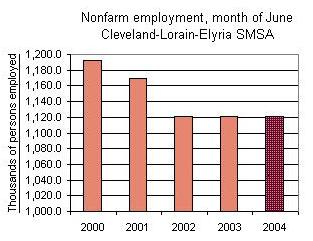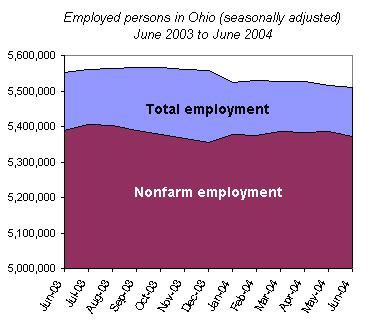CITY COUNCIL'S PROJECT LIST: WHERE ARE THE PEOPLE? The PD
reported last Tuesday that Cleveland City Council and Mayor Campbell have agreed to a bond issue to raise $20 million for small economic development projects. The City will use repayments from its portfolio of old UDAG loans to pay off the new bonds, which means the Mayor and Council are borrowing against future income to create a pot of strategic ready cash.
Council's list of 21 priority projects, one for each ward, is
here (pdf file). The PD's predictable problem with The List is the absence of downtown projects (apparently Councilman Cimperman's priority, live-work housing conversion on East 30th, isn't "downtown" enough). It seems that the Campbell Administration shared this concern, because a fifth of the pot is now targeted for downtown, whatever that means. The remaining $16 million -- $800,000 per ward, more or less -- is for the rest of us.
The history of this deal, you'll remember, goes back to the Great Convention Center Negotiation of 2003, when Frank Jackson demanded money for strategic neighborhood investments as the price of City Council's support for any deal. Campbell agreed to the concept and pointed to the availability of her "Core City Fund", another bond-financed pot underwritten by revenue from the City's Chagrin Highlands development deals. The Convention Center process fizzled, but Jackson made clear he would keep pushing for his agenda, and now it looks like he'll be able to deliver something -- committed cash, if not shovels in the ground -- in time for Council Members' re-election campaigns in 2005.
In principle, I strongly support Jackson's approach. Heck, I support it in practice -- it's sure better than nothing, which is the amount of new cash that Councilmen and their constituents could expect for local priorities if they'd left it up to the other side of City Hall.
But looking at Council's list of "Economic Development Priorities", a person has to ask: Are
these the best
economic development initiatives they can devise for $800,000 per ward in unencumbered cash?
The striking thing about Council's project list is that it's all about real estate... vacant buildings, land assembly, retail area improvements, a couple of parks. This is standard-issue Cleveland "community development strategy"; renovate a building, clean up some land, put in new curbs and lights, build some new houses, and somehow safety and prosperity will follow for your residents. It ain't necessarily so.
Take, for example, the City Council ward where I live.
The "priority economic development project" for my ward is a $1.8 million renovation of an old Masonic Hall on West 25th, two blocks from my house. The Councilwoman wants to subsidize the conversion of the first floor into four retail spaces, and the two upper floors to "residential, possibly live work space". The building sits between a McDonald's and the local hunger center (which is expanding); it's across the street from an Aldi's, routinely crowded with poor people looking for off-brand groceries. The neighborhood strip plaza up the street, the Councilman's pride when it was built ten years ago, now almost always includes beggars in the shopping experience.
The two adjacent census tracts (1055 and 1056.2) were home to 1,113 families in 1999, the last census year. 24% were living below the Federal poverty line A quarter of the families had annual incomes of less than $15,000. 45% had incomes below $25,000. Of local residents "in the labor force", 11% were unemployed. (This was in 1999, when the official citywide unemployment rate was about 9% -- it's now hovering around 13%.) A third of adult residents lacked a high school diploma or GED certificate, and only 8% had four-year college degrees.
Why would the Councilwoman representing these families make the reuse of an old Masonic Hall -- a little retail space, a few live-work apartments -- her "economic development priority"? What opportunities will it bring them? Maybe a handful of $8 retail jobs, or a chance to clean the halls. How is this a "strategic investment" for the community?
Instead of one more building, why not consider an $800,000 strategic investment in the people themselves?
For example:
1) For $800,000, we could buy the neighborhood a really terrific community technology training center for four or five years. Like Tri-C's
Rainbow Terrace Family Learning Center, which is not only teaching low-income parents computer skills but getting them through their GED exams and into college... or the Cleveland Housing Network's
"Bringing IT Home", which combines computer training with financial literacy, getting hundreds of adults' credit repaired so they can get a small loan to buy a computer... or Esperanza's very low-budget program, which trained over a hundred low-income adults last year in MS Office applications and job search skills, and helped most of them get into jobs or college.
A fully funded, $200,000-a-year neighborhood center could reasonably expect to connect several hundred underemployed, undereducated neighbors with this kind of training every year. In four years that could add up to a thousand people on the path to better educations and incomes. Wouldn't that be a more "strategic" investment for the community than one more rehabbed building?
2) Or we could invest $800,000 in helping ward residents with high school diplomas to go to college. Let's say we formed a partnership with the
Cleveland Scholarship Program and Tri-C, spent $100,000 to put a full-time college recruiter/counselor in the Councilwoman's ward office for two years, and used the rest of the money for scholarships (or to subsidize and guarantee loans) to help neighbors get Tri-C associate degrees? Suppose we pulled Metrohealth (by far our biggest local employer) into the partnership, and targeted those scholarships and loans to health industry job credentials? Don't you think that would be more productive for local employment than four retail spaces and a few apartments?
I'm picking on my Councilwoman here, which isn't fair; I'm sure she was asked to choose a project for The List, and simply chose one she thought made sense. City Hall isn't used to thinking of investment in human beings as neighborhood development. That's a natural reflection of the city's CDC paradigm, which has evolved over twenty-five years of struggling for public/private reinvestment in neighborhood housing, retail space and infrastructure. Council's "Economic Development Priorities" adhere faithfully and honestly to that paradigm.
But by now it should be clear that the CDC paradigm -- at least its Cleveland version -- is not really about economic development. Buildings don't earn income or create wealth, people do. In the 21st century, we mostly do it with intellectual assets -- education, information, skills. People who are uneducated, disconnected from the relevant technology, and stuck in low-value-added occupations will not sustain healthy, prosperous neighborhoods, no matter how many "projects" happen around them.
Cleveland's neighborhoods need a new "development" paradigm for the new economy, and we need it now.
A wide-open public discussion of The List -- our Council Members' declared priorities for strategic economic investments in their wards -- would be an excellent step in that direction.

